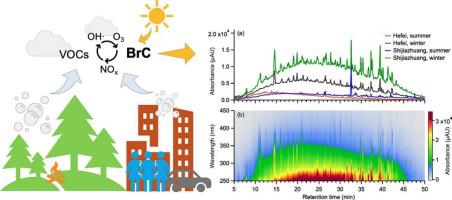当前位置:
X-MOL 学术
›
Sci. Total Environ.
›
论文详情
Our official English website, www.x-mol.net, welcomes your feedback! (Note: you will need to create a separate account there.)
Variability in molecular composition and optical absorption of atmospheric brown carbon aerosols in two contrasting urban areas of China
Science of the Total Environment ( IF 9.8 ) Pub Date : 2024-03-19 , DOI: 10.1016/j.scitotenv.2024.171820 Yue Lin , Yuemei Han , Guohui Li , Lijuan Li , Xin Zhang , Junji Cao
Science of the Total Environment ( IF 9.8 ) Pub Date : 2024-03-19 , DOI: 10.1016/j.scitotenv.2024.171820 Yue Lin , Yuemei Han , Guohui Li , Lijuan Li , Xin Zhang , Junji Cao

|
Atmospheric brown carbon (BrC) aerosols were investigated at two urban sites in southern (Hefei) and northern (Shijiazhuang) China during summer and winter of 2019–2020 to explore regional variability in their compositional and optical properties. Organic matter in ambient PM samples were characterized at molecular level using ultrahigh performance liquid chromatography coupled with a diode array detector and an Orbitrap mass spectrometer. Although the molecular composition of organic aerosols varied substantially over different ambient environments, they were mainly composed by CHO and CHON species in positive ionization mode while CHO and CHOS species in negative mode. The mass absorption coefficients of BrC aerosols at wavelength range 250–450 nm were relatively higher for winter samples in both cities and for Shijiazhuang samples in both seasons, partly attributed to the higher concentration levels of anthropogenic air pollutants in these environments. The absorption Ångström exponents further revealed that BrC aerosols in winter seasons and in Shijiazhuang had a greater capacity of absorption at shorter wavelengths. A total of 26 BrC species with strong absorption were unambiguously identified from different environments, which mainly consisted of CHO, CHON, and CHN species and had higher degrees of unsaturation and lower degrees of oxidation. The presence and abundance of these BrC species varied dynamically across the seasons and cities, with a greater number of species presented in the winter of Shijiazhuang. The BrC species together contributed 12–26 % in the total absorbance of light-absorbing organic components at 250–450 nm. This study highlights the regional differences in BrC properties influenced by the sources and atmospheric processes, which should be taken into account to assess their climate impacts.
更新日期:2024-03-19



























 京公网安备 11010802027423号
京公网安备 11010802027423号